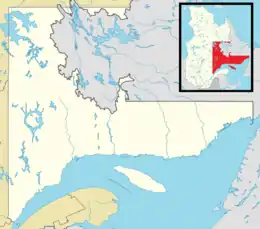Pointe-Lebel | |
|---|---|
 Pointe-Lebel Location in Côte-Nord region of Quebec. | |
| Coordinates: 49°10′N 68°12′W / 49.167°N 68.200°W[1] | |
| Country | |
| Province | |
| Region | Côte-Nord |
| RCM | Manicouagan |
| Constituted | January 1, 1964 |
| Government | |
| • Mayor | Mr. Rene Labrosse |
| • Federal riding | Manicouagan |
| • Prov. riding | René-Lévesque |
| Area | |
| • Total | 121.30 km2 (46.83 sq mi) |
| • Land | 84.79 km2 (32.74 sq mi) |
| Population (2011)[3] | |
| • Total | 1,973 |
| • Density | 23.3/km2 (60/sq mi) |
| • Pop 2006-2011 | |
| • Dwellings | 928 |
| Time zone | UTC−5 (EST) |
| • Summer (DST) | UTC−4 (EDT) |
| Postal code(s) | |
| Area code(s) | 418 and 581 |
| Highways | |
| Website | www |
Pointe-Lebel is a village municipality in the Côte-Nord region of Quebec, Canada. Its territory makes up the western half of the Manicouagan Peninsula between the mouths of the Outardes and Manicouagan Rivers.
Demographics
In the 2021 Census of Population conducted by Statistics Canada, Pointe-Lebel had a population of 1,817 living in 857 of its 935 total private dwellings, a change of -5.3% from its 2016 population of 1,918. With a land area of 85.54 km2 (33.03 sq mi), it had a population density of 21.2/km2 (55.0/sq mi) in 2021.[4]
Population trend:[5]
- Population in 2011: 1973 (2006 to 2011 population change: 0.8%)
- Population in 2006: 1958
- Population in 2001: 1931
- Population in 1996: 2011
- Population in 1991: 1818
Mother tongue:
- English as first language: 0.5%
- French as first language: 98.0%
- English and French as first language: 0%
- Other as first language: 1.5%
References
- ↑ "Banque de noms de lieux du Québec: Reference number 50165". toponymie.gouv.qc.ca (in French). Commission de toponymie du Québec.
- 1 2 Ministère des Affaires municipales, des Régions et de l'Occupation du territoire - Répertoire des municipalités: Pointe-Lebel
- 1 2 Statistics Canada 2011 Census - Pointe-Lebel census profile
- ↑ "Population and dwelling counts: Canada, provinces and territories, and census subdivisions (municipalities), Quebec". Statistics Canada. February 9, 2022. Retrieved August 28, 2022.
- ↑ Statistics Canada: 1996, 2001, 2006, 2011 census
This article is issued from Wikipedia. The text is licensed under Creative Commons - Attribution - Sharealike. Additional terms may apply for the media files.